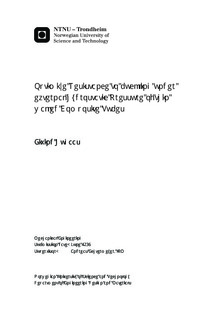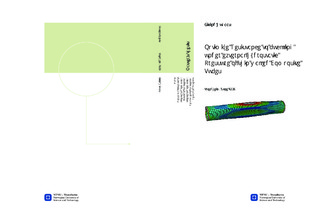| dc.description.abstract | Composite tubes are a very good alternative to steel tubes in applications requiring low weight and high stiffness. For composite tubes to replace traditional steel tubes in demanding environments, such as in the subsea petroleum industry, more research on their behavior has to be made to qualify the performance. This thesis seeks to expand that knowledge by investigating the buckling behavior of composite tubes subjected to external hydrostatic pressure. To find a method of correctly predicting the stress and strain states on the tubes, a comparison between FEA and previously acquired strain data from external hydrostatic pressure testing of a composite tube has been carried out. The composite tube had a length of 600 mm and a diameter of 100 mm and was filament wound with a layup of [89$^\circ{}_1$/12.7$^\circ{}_1$/45$^\circ{}_1$] and instrumented with optical fiber to acquire the strain data. It was found that by modeling the cross section of the tube elliptic with 0.46 \% ("0.46 \% ovality") of the mean diameter added and subtracted to the major and minor diameter of the ellipse respectively, a very good match between FEA and the strain data was found. Using the same ovality, seven different layups were analyzed to find an optimal layup for withstanding external hydrostatic pressure. Based on the optimal layup assessment, the most optimal layup, [89$^\circ{}_2$/12.7$^\circ{}_1$/89$^\circ{}_2$], was produced. The tube was cut into lengths of 300, 400 and 600 mm to assess the buckling behavior and FEA matching's dependency on length. The tubes were instrumented with optical fiber for strain measurements and tested in an autoclave. It was found that the [89$^\circ{}_2$/12.7$^\circ{}_1$/89$^\circ{}_2$] layup performed well having a buckling pressure of 9.75 bar for the 600 mm long tube, 2.79 times that of the [89$^\circ{}_1$/12.7$^\circ{}_1$/45$^\circ{}_1$] layup, despite being just 33.5 \% thicker. To achieve a good match in FEA for the [89$^\circ{}_2$/12.7$^\circ{}_1$/89$^\circ{}_2$] layup, the fiber direction E-modulus had to be increased by 12 \% to 37738 MPa, compared to the predicted E-modulus from volume fraction scaling. The high E-modulus was concluded as being due to low void content coming from post winding compression of the tubes with peel ply. The ovality needed to achieve matching for the 600 mm long tube was 0.01\%. Based on the matching of the shorter tubes it was concluded that longer tubes with the same layup will need an ovality close to 0.01\% to simulate correct strain behavior. | nb_NO |

